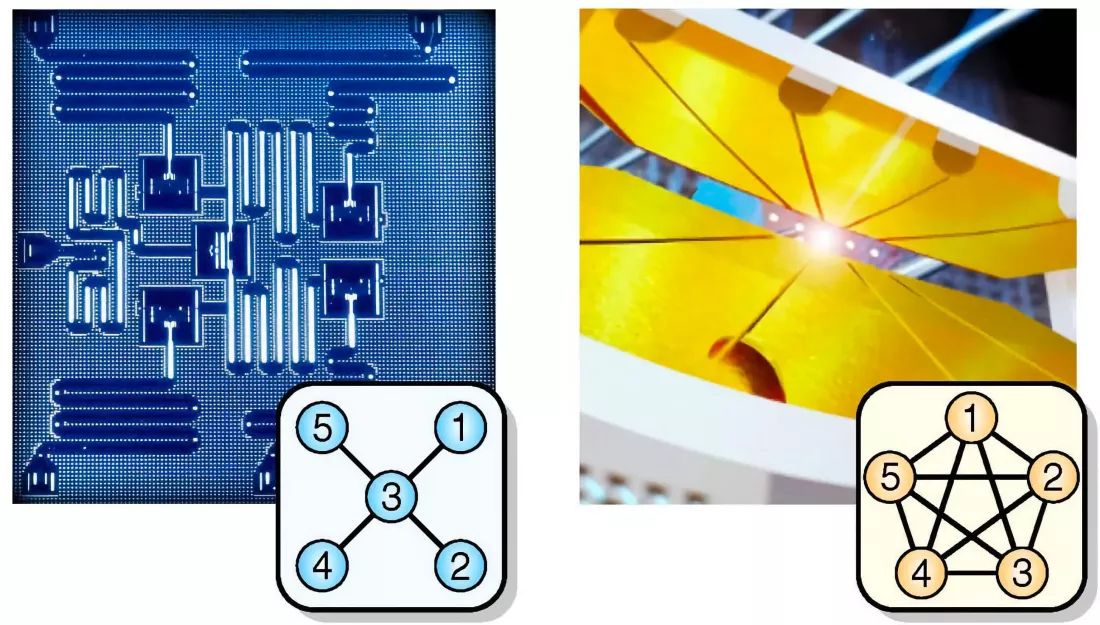Creating Time Crystals Using New Quantum Computing Architectures

“A time crystal is perhaps the simplest example of a non-equilibrium phase of
matter,” said Yao, UC Berkeley associate professor of physics. “The QuTech
system is perfectly poised to explore other out-of-equilibrium phenomena
including, for example, Floquet topological phases.” These results follow on the
heels of another time crystal sighting, also involving Yao’s group, published in
Science several months ago. There, researchers observed a so-called prethermal
time crystal, where the subharmonic oscillations are stabilized via
high-frequency driving. The experiments were performed in Monroe’s lab at the
University of Maryland using a one-dimensional chain of trapped atomic ions, the
same system that observed the first signatures of time crystalline dynamics over
five years ago. Interestingly, unlike the many-body localized time crystal,
which represents an innately quantum Floquet phase, prethermal time crystals can
exist as either quantum or classical phases of matter. Many open questions
remain. Are there practical applications for time crystals? Can dissipation help
to extend a time crystal’s lifetimes? And, more generally, how and when do
driven quantum systems equilibrate?
Why Tree-Based Models are Preferred in Credit Risk Modeling?

Credit risk models are used by financial organizations to assess the credit risk
of potential borrowers. Based on the credit risk model validation, they decide
whether or not to approve a loan as well as the loan’s interest rate. New means
of estimating credit risk have emerged as technology has progressed, like credit
risk modelling using R and Python. Using the most up-to-date analytics and big
data techniques to model credit risk is one of them. Other variables, such as
the growth of economies and the creation of various categories of credit risk,
have had an impact on credit risk modelling. Machine learning enables more
advanced modelling approaches like decision trees and neural networks to be
used. This introduces nonlinearities into the model, allowing for the discovery
of more complex connections between variables. We selected to employ an XGBoost
model that was fed with features picked using the permutation significance
technique. ML models, on the other hand, are frequently so complex that they are
difficult to understand. We chose to combine XGBoost and logistic regression
because interpretability is critical in a highly regulated industry like credit
risk assessment.
Intelligent Automation: What’s the Missing Piece of AIOps?

Up until now, AIOps has mostly been used in the context of monitoring. As a
buzzword, people tend to think of the term in relation to creating baselines for
your data and then alerting to any deviations, connecting multiple sources of
information to find the root cause for a problem. These are powerful use cases
and are allowing businesses to find correlations that they might not have
achieved without AI. For example, you might find that poor bandwidth in a
specific region led to an increase in tickets from customers within that
location, or that you have idle cloud resources that are costing you in storage
or compute dollars behind the scenes, allowing you to make manual changes to
optimize costs. However, in many ways, categorizing AIOps as just monitoring and
detection doesn’t make it that different from the previous category of IT
operations analytics, where companies would look at operational data, including
logs and security feeds, and then aggregate these to make smarter decisions. To
get more out of AIOps, companies need to move past simple monitoring use cases,
and look toward management of the cloud with the help of automation.
The State of Quantum Computing Systems

Quantum computing “systems” are still in development, and as such the entire
system paradigm is in flux. While the race to quantum supremacy amongst nations
and companies is picking up pace, it’s still at a very early stage to call it a
“competition.” There are only a few potential qubit technologies deemed
practical, the programming environment is nascent with abstractions that have
still not been fully developed, and there are relatively few (albeit extremely
exciting) quantum algorithms known to scientists and practitioners. Part of the
challenge is that it is very difficult and nearly impractical to simulate
quantum applications and technology on classical computers -- doing so would
imply that classical computers have themselves outperformed their quantum
counterparts! Nevertheless, governments are pouring funding into this field to
help push humanity to the next big era in computing. The past decade has shown
an impressive gain in qubit technologies, quantum circuits and compilation
techniques are being realized, and the progress is leading to even more (good)
competition towards the realization of full fledged quantum computers.
Build Your First Machine Learning Model With Zero Configuration — Exploring Google Colab
You may be wondering what’s the point of training an ML model. Well, for
different use cases, there are different purposes. But in general, the purpose
of training an ML model is more or less about making predictions on things that
they’ve never seen. The model is about how to make good predictions. The way to
create a model is called training — using existing data to identify a proper way
to make predictions. There are many different ways to build a model, such as
K-nearest neighbors, SVC, random forest, and gradient boosting, just to name a
few. For the purpose of the present tutorial showing you how to build an ML
model using Google Colab, let’s just use a model that’s readily available in
sklearn — the random forest classifier. One thing to note is that because we
have only one dataset. To test the model’s performance, we’ll split the dataset
into two parts, one for training and the other for testing. We can simply use
the train_test_split method, as shown below. The training dataset has 142
records, while the test dataset has 36 records, approximately in a ratio of 4:1.
Have you traded on-premise lock-in for in-cloud lock-in?

In a global marketplace, being tied to one cloud service can be either
impossible to achieve or not tolerable to the business, so cloud vendor
neutrality becomes important. Practicality is one driver for always being open
to multiple cloud solutions. There’s also vendor strategy: you will get driven,
hard, to opt for its version of key parts of the software stack; their cloud
version of database, say, as Amazon doesn’t want you to move your Oracle apps
onto Amazon, but the Amazon database products instead. In and of itself, that’s
not a crazy or risky decision; there are advantages to doing that if you are an
Amazon customer already, and there will probably be economies of scale. It might
even be cheaper (although that isn’t always the case with cloud contracts). This
may feel like an easier solution to adopt, but could be a real headache if you
have committed to microservices and have all kinds of open source apps running
all over the place (as you want to, as it’s horses for courses here), and the
database at the back is an Amazon database.
A CIO's Introduction to the Metaverse

Collaboration is one of three primary use cases for a metaverse in the
enterprise right now, according to Forrester VP J.P. Gownder. Another primary
use case is one championed by chip giant Nvidia -- simulations and digital
twins. Huang announced Nvidia Omniverse Enterprise during his keynote address at
the company’s GTC 2021 online AI conference this month and offered several use
cases that focused on simulations and digital twins in industrial settings such
as warehouses, plants, and factories. If you are an organization in an industry
with expensive assets -- for instance oil and gas, manufacturing, or logistics
-- it makes sense to have this use case on your radar, according to Gartner’s
Nguyen. “That’s where augmented reality is benefiting enterprise right now,” he
says. As an example, during his keynote address, Nvidia’s Huang showed a video
of a virtual warehouse created with Nvidia Omniverse Enterprise enabling an
organization to visualize the impact of optimized routing in an automated order
picking scenario. That’s an example of a particular use case, but Omniverse
itself is Nvidia’s platform to enable organizations to create their own
simulations or virtual worlds.
Misconfigured FBI Email System Abused to Run Hoax Campaign

The FBI says the misconfiguration involved the Law Enforcement Enterprise
Portal, or LEEP, which allows state, local and federal agencies to share
information, including sensitive documents. The portal also supports a Virtual
Command Center, which allows law enforcement agencies to share real-time
information about events such as shootings and child abductions. Although the
abused email server is operated by the FBI, the bureau issued an updated
statement Sunday noting that the server is not part of the bureau's corporate
email service, and that no classified systems or personally identifiable
information was compromised. "No actor was able to access or compromise any data
or PII on the FBI's network," the FBI says. "Once we learned of the incident, we
quickly remediated the software vulnerability, warned partners to disregard the
fake emails, and confirmed the integrity of our networks." The hacker-crafted
note, a copy of which has been released by Spamhaus, warned that data had
potentially been exfiltrated.
Change management: 9 ways to build resilient teams

Resilience may be misunderstood as the ability to bounce back instantly from
difficulties or to roll with any manner of punches. Defining or encouraging
mindless acceptance of workplace stressors is a recipe for burnout. “The problem
is when leadership focuses on building a team’s resilience as a way to avoid
addressing unnecessary causes of stress that are part of the organization’s
culture,” says David R. Caruso, Ph.D., author of A Leader’s Guide to Solving
Challenges with Emotional Intelligence. “We will not, nor should we, try to
meditate our way out of a toxic culture. Buying everyone a yoga mat while
failing to address sources of unnecessary stress is a problem.” Therefore, it’s
importance that IT leaders understand the state of affairs within the IT
organization and actively address issues and drivers of burnout. “Burnout and
change fatigue – disengagement that comes from constant or poorly managed change
– are very real risks for team members and organizations,” says Noelle Akins,
leadership coach and founder of Akins & Associates. “Resilience is not just
non-stop adaptability.”
How Happiness Technology Is Affecting Our Everyday Lives
Improving employee happiness helps businesses, too. Utilizing this AI technology
allows companies to track what's called "psychological capital," a phrase coined
by professor Fred Luthans. Helping employees improve their scores not only makes
people happier, but also significantly increases productivity and profit for
companies. But what about using AI to make us happier outside of work? Happiness
technologies have their place in our personal lives as well. ... One problem
that the business world has been working on for years is finding a reliable,
discreet way to analyze the day-to-day activities of employees to increase
productivity and engagement. Research clearly shows that happiness is correlated
to better performance, so this trend of tracking and improving employee
happiness has gained popularity. On the back of this trend, AI is being used for
robotic process automation (RPA) and content intelligence.
Quote for the day:
"Leadership is a matter of having
people look at you and gain confidence, seeing how you react. If you're in
control, they're in control." -- Tom Landry
No comments:
Post a Comment